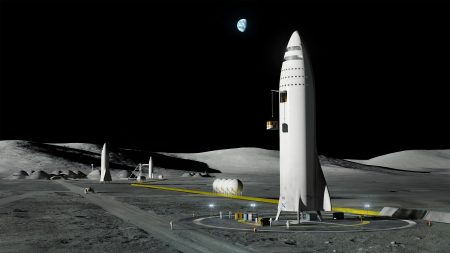February 16, 2019 – The Starship that is in development by SpaceX represents a total departure from the way NASA envisions its return to the Moon technology. NASA wants to build a lunar gateway in orbit around the Moon, a mini version of the International Space Station. It then wants to deliver to it a lunar landing technology that in many ways copies the design of the LEM, the Lunar Excursion Module used in the Apollo program.
If you are too young to remember how the LEM was designed, it included a descent module and ascent module. Astronauts decoupled from their Apollo mothership and descended to the lunar surface using the engines of the descent module. After exploring the surface they then left behind the descent module engine and its base, and using the rocket of the ascent module rose to rendezvous and reconnect with the Apollo Command Module. So, in effect, NASA wants to continue using a three-stage methodology for lunar activity.
Not SpaceX. Elon Musk’s company is building a two-stage rocketship. The first stage is called the Super Heavy. The second which is being prototyped will be the Starship. The prototype, that stainless steel stubby rocket being assembled in South Texas, is called the Starhopper. It is intended to be launched and landed extensively in 2019 to ensure it meets the expectations of the company, to produce a single-stage solution for landing on the Moon, or in the future, on Mars. SpaceX doesn’t need a lunar gateway in orbit to fulfill its plans to land on the Moon. Part of SpaceX plans includes a voyage around the Moon in 2023 by a space tourist and invited guests who will ride in the Starship. Then SpaceX may take the next step and land the Starship on the Moon and take off from there to return to Earth.
Meanwhile, NASA has announced what it refers to as an ambitious plan to get back to the lunar surface to stay. The timetable to build the lunar gateway has a completion date of 2024. Getting down to the surface will happen in 2026 or later. The official name of the gateway is the Lunar Orbital Platform-Gateway, or LOP-G, a 55-ton, multi-compartmented, modular space station (see image below) to act as an in lunar orbit habitat, maintenance hub, and launch platform to the lunar surface.
The first sections of LOP-G which will include power and propulsion are scheduled to be completed and deployed in 2022. The remaining modules including the habitat, airlock, and maintenance hub would be delivered by NASA’s super-heavy Space Launch System, the SLS, scheduled for its first flight in 2020, a three-week crewless mission to cislunar space and back. The SLS is years late and billions of dollars over budget. And being largely a throwaway rocket seems like a make-work project for a bunch of NASA contractors.
When you compare the two approaches, there is an elegance to what SpaceX has in mind. And as for the cost of what this commercial rocket company is proposing, much of the cost of development to-date is currently being borne through revenues earned from commercial and NASA launch contracts.
SpaceX may be overly ambitious in their timelines but you can bet the cost of delivery will be far less than what NASA, in its plans, is intending to build. And NASA hasn’t exactly executed meeting its deadlines on SLS, so why should we expect the organization to be any more successful in developing and delivering LOP-G, which at present, only exists on paper.
And here’s another tidbit of information which makes me suspicious of NASA’s plans. The LOP-G looks suspiciously like a May 2016 proposal made by Lockheed Martin called the Martian Orbiting Laboratory. Lockheed’s chief technologist for civil space exploration, Tony Antonelli, envisioned a deep space platform with a central-core cis-Martian habitat to circle the Red Planet and act as a launch platform for crewed missions to the surface. Lockheed didn’t put a price on what was being spitball proposed, but when you consider the cost of the International Space Station at $100 billion USD, it is likely that whatever NASA puts in lunar orbit will run into the tens of billions. And don’t be surprised if Lockheed Martin isn’t the principal contractor.
I would argue that there is a use for a permanent orbiting, or LaGrange-point located human habitat in the cislunar space. It is probably, over time, an essential waystation for human exploration and occupation of Deep Space. But there is less justification for it if a company like SpaceX can get human crews to the Moon and back with a single-stage solution, and do it at a fraction of the cost. If I were NASA I’d be putting my money on SpaceX and likely saving a bundle for American taxpayers.

















